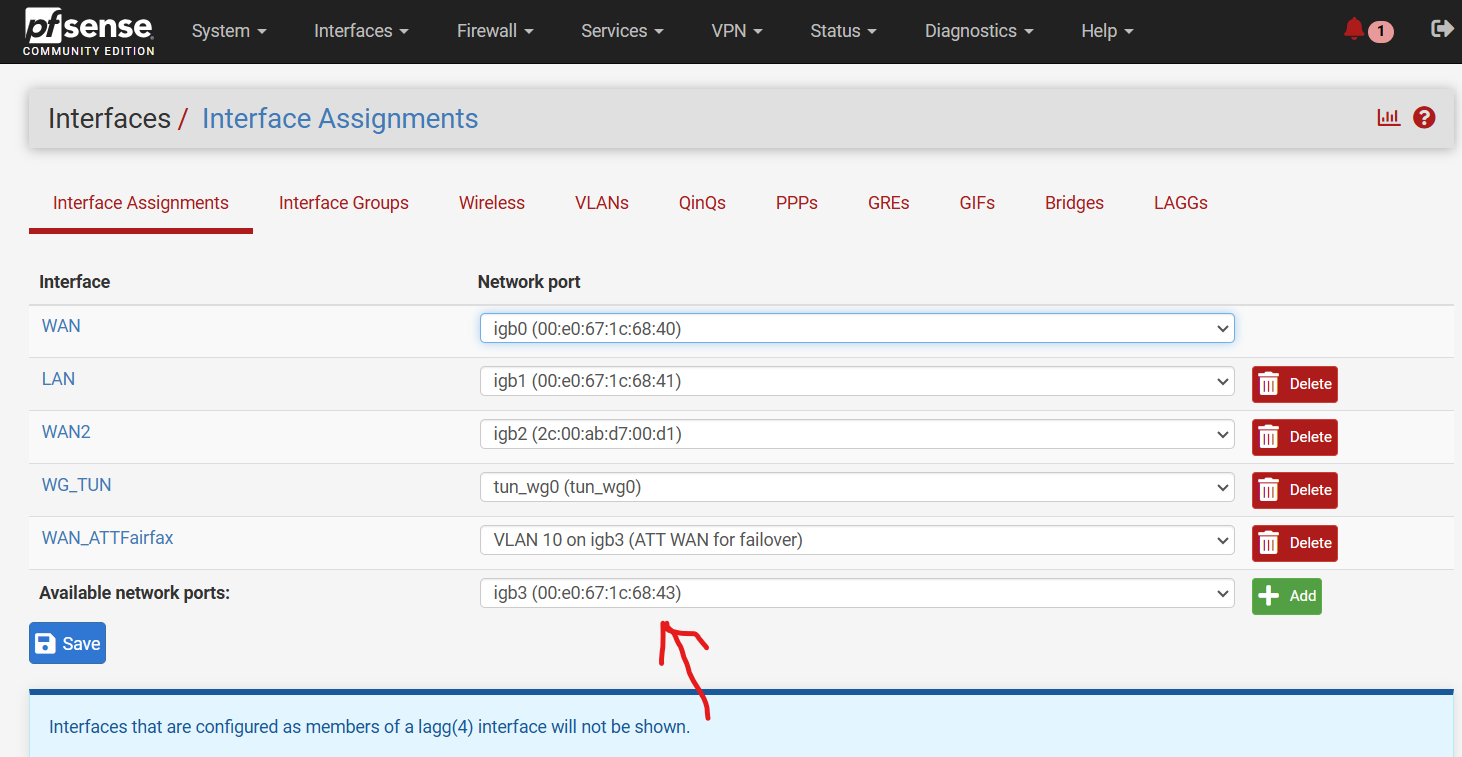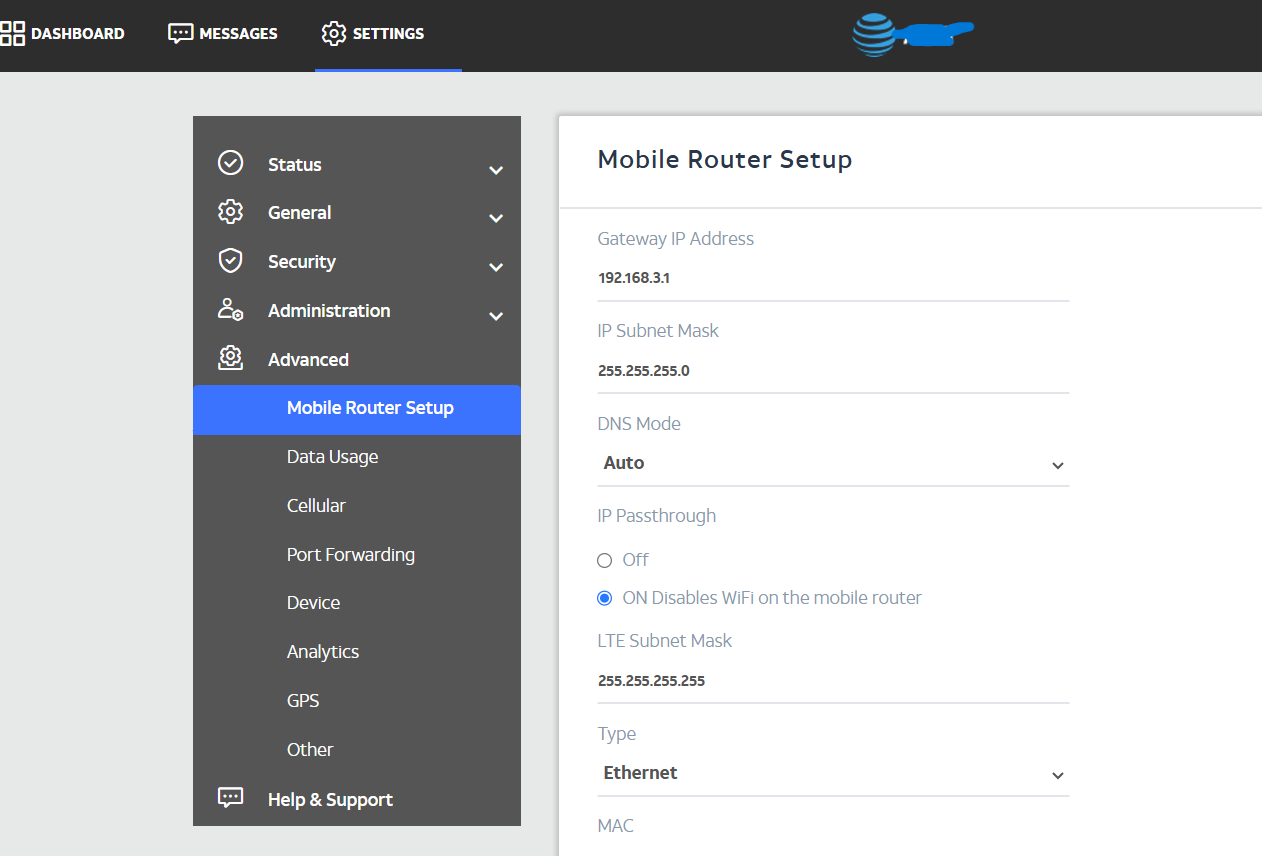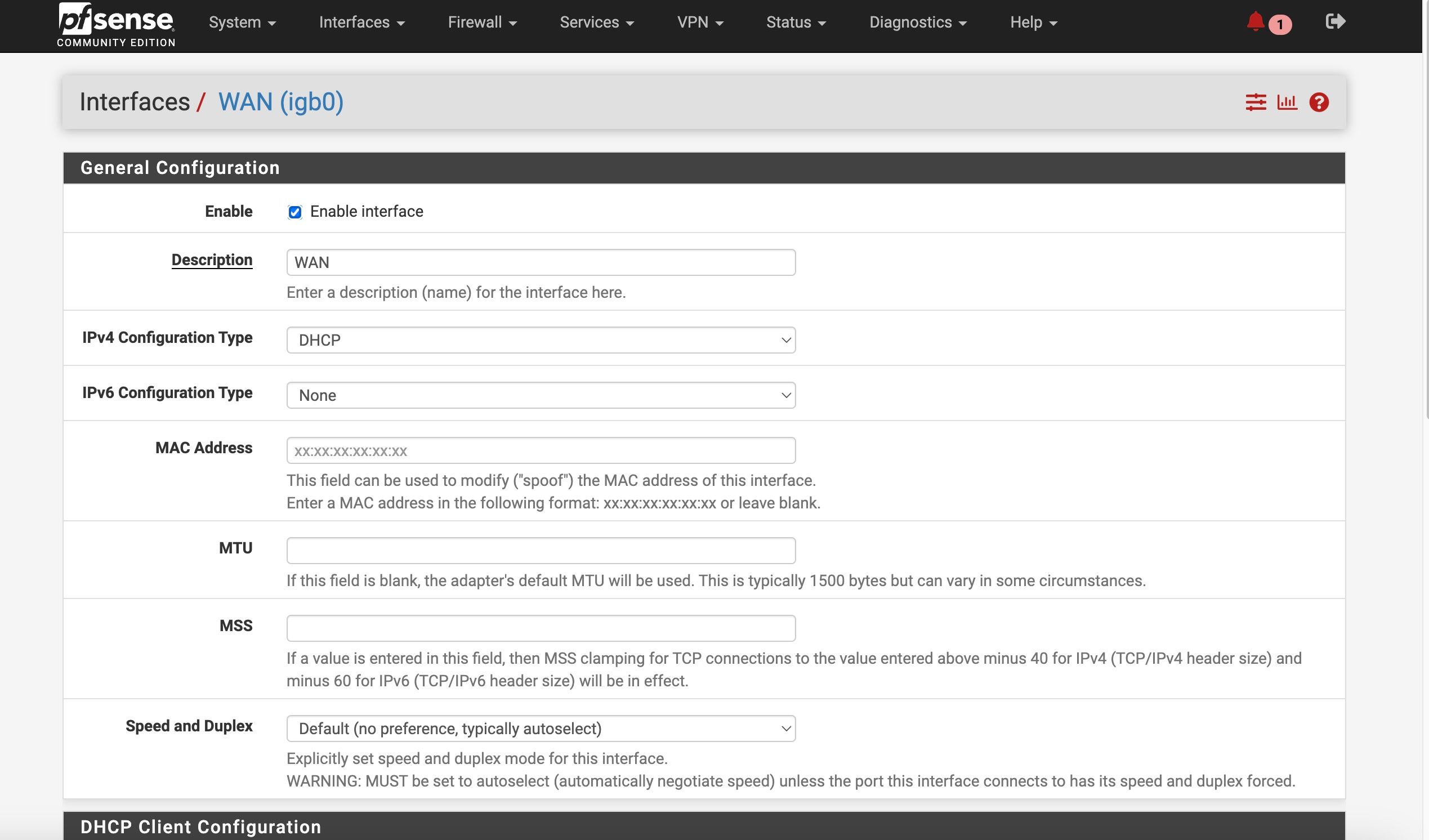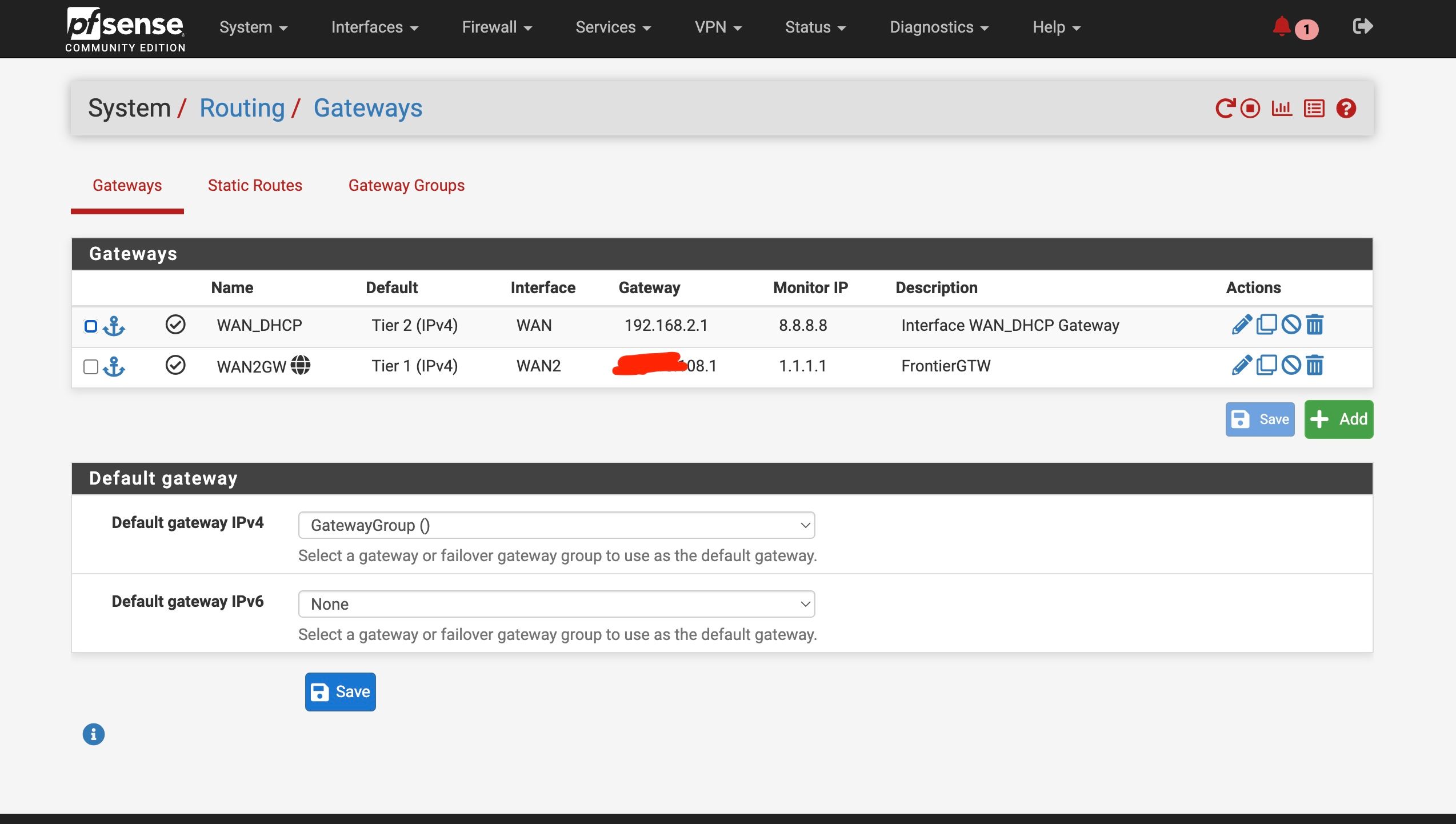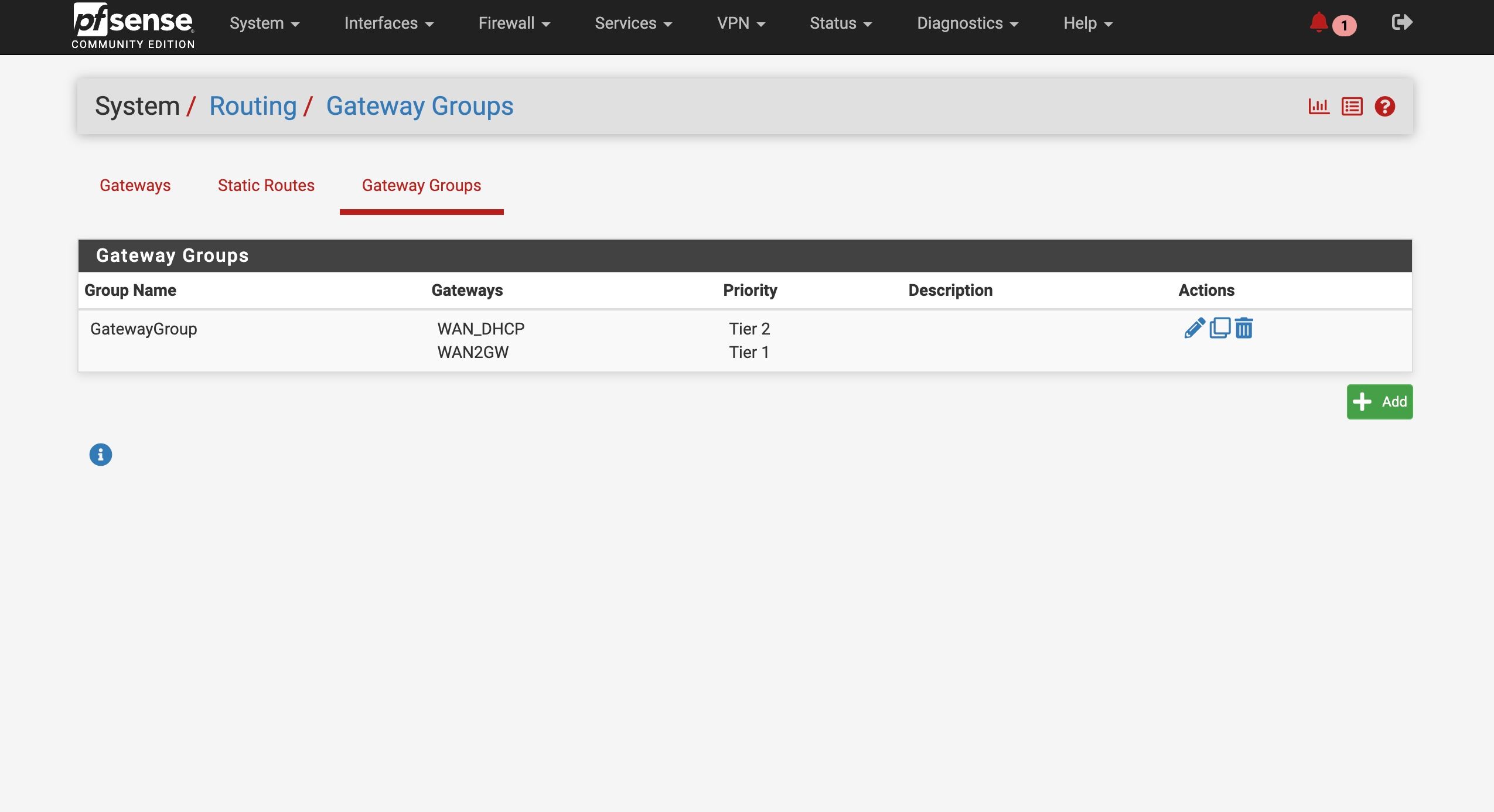ATT Internet AIr
-
@ahole4sure said in ATT Internet AIr:
The current trouble I am having is that my identical ATT device, when connected to port 2 of the switch, is not passing through the IP address when I created or setup the interface as DHCP -- the other ATT device when connected directly to one of the pfsense interfaces pushed through ATT static publc IP address. And if I try to set the IP address manually it doesn't behave correctly- says offline
Looking at your picture, I see WAN, LAN and WAN2. So what is it that you are trying to do with the ATT modem now, connecting it to the fourth port? Are you trying to add a third WAN?
I don't understand the direction... If your VLAN is set up on pfsense, you make port 1 a TRUNK port as you said, but that means TAGGED 10. And the ports for any devices that should only belong to VLAN 10 need to be untagged and only members of VLAN 10. Currently all ports are also members of VLAN 1...
If you are trying to get an IP on port 4 on pfsense (igb3) from the ATT modem, you can simply make both ports 1 and 2 VLAN 10 UNTAGGED on the switch. Remove them from any other VLAN memberships.
This way you have created a "switch within the switch", where port 1 and 2 are connected but separate from the other ports. Pfsense doesn't need to know of any VLAN on igb3 for this to work... -
Yup that^. Port 1 should be tagged for VLAN 10 because it has to pass tragged traffic to pfSense. Port 2 should be untagged for VLAN 10 and have the PVID set as 10 (as it is).
-
Thanks for input
Yes @Gblenn my apologies for confusion -- the weird setup is because it is just for testing (and being done on the system that is currently available to me - and yes in this test, adding a third WAN)
Once I get a confirmation that I can set this up and it will function properly then the real situation is depicted in the attached.Basically the real setup needs to have proper switch setup for the current "Camera" interface to be split so that the newly added switch can accept 2 ports (one for the newly added ATT modem and the original camera network) - see diagram.

The reason for the change is to add a failover internet scource but i have no availabe addnl ports on the pfsense box.
In this real case scenario I will have the camera VLAN as ID 20So any input on how I would setup the switch (membership, tagging etc) would be appreaciated !! I have a feeling when the light goes off it is going to be easier -- but initially setting up the switch and VLANs is not as intuitive as I had thought. ugh
-
As discussed you can use just one VLAN there and have untagged traffic for the other subnet. But I would avoid that and use two VLANs instead because it avoid a bad config putting traffic onto the wrong interface.
So I would add VLANs 10 and 20. Make port 1 tagged for both those.
Make port 2 untagged for VLAN 10 with PVID 10.
Make port 3 untagged for VLAN 20 with PVID 20.
-
Another question for the situation (and in general)
So in general when you make an interface assignment and connection to VLANs (like in my case) do you need to delete the physical connection assignment - ie Camera in theis case?
And then of course make the new assignments to whatever VLANs you are connecting there?Is there an easy way to transfer or use all of the current network settings (rules, routing etc) for the Camera network - or in my case do I just leave it as it is and traffice gets passed to port 3 just like it is coming to igc3 natively currently?
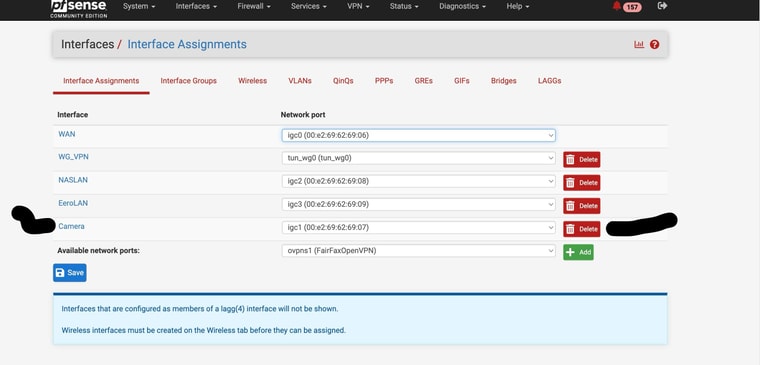
-
You don't need to remove the parent interface, you can still use the untagged interface. But I would avoid that as I said.
You can just re-assign Cameras, for example, from igc1 to the VLAN igc1.10. All the rules etc will follow it.
-
@stephenw10
Thanks
But in this case would it be better to create a seperate VLAN for the Cameras , ie VLAN ID 20 ;
Since the new failover modem is on VLAN 10 IDDon't I need to have the modem and cameras on differnt VLANs or is it not necessary?
And if that is the case - would I tag Port 1 with VLAN 10 and 20??
-
Yes use VLAN 20 for Cameras if you;re already using VLAN 10 for the second WAN.
Yes port 1 has to be a tagged member on all VLANs it's carrying.
-
Thanks again
I made the changes that I thought you suggested. It appears things worked - my testing with both the ATT devices gave some squirrley results as far as consistency but I think it at least worked.What didn't happen was that with the modem connected through the switch and setting the VLAN(10) interface to DHCP it still didn't recieve the IP address (Local or public) and didn't create a gateway. However , it seemed to work when I gave the VLAN10 interface the static public IP address and created a gateway. No problem - I just wanted to make sure the slight different behavior (vs when I connected the ATT modem to a fixed port) wasn't due to me still not having the switch set up correctly??
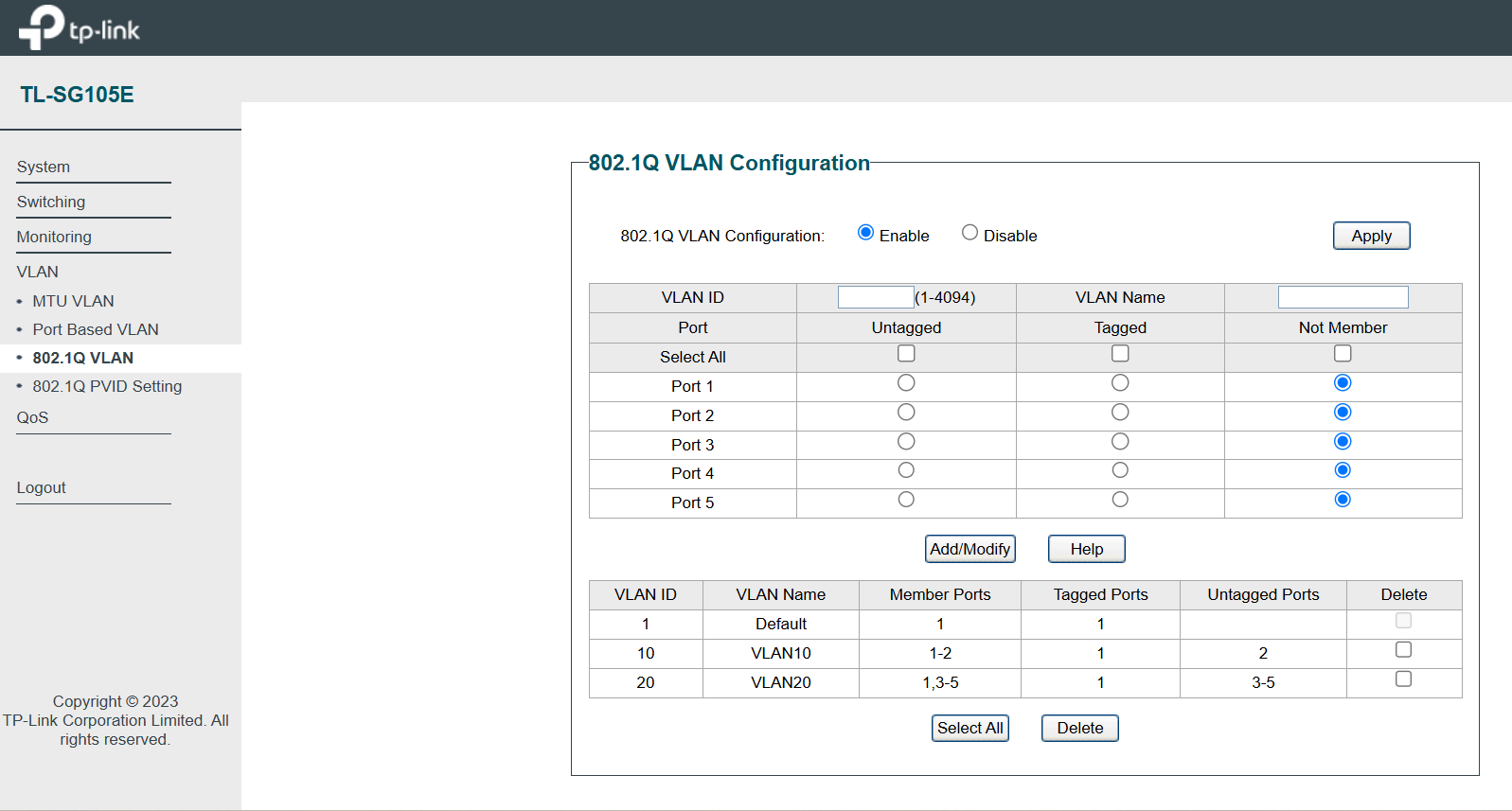
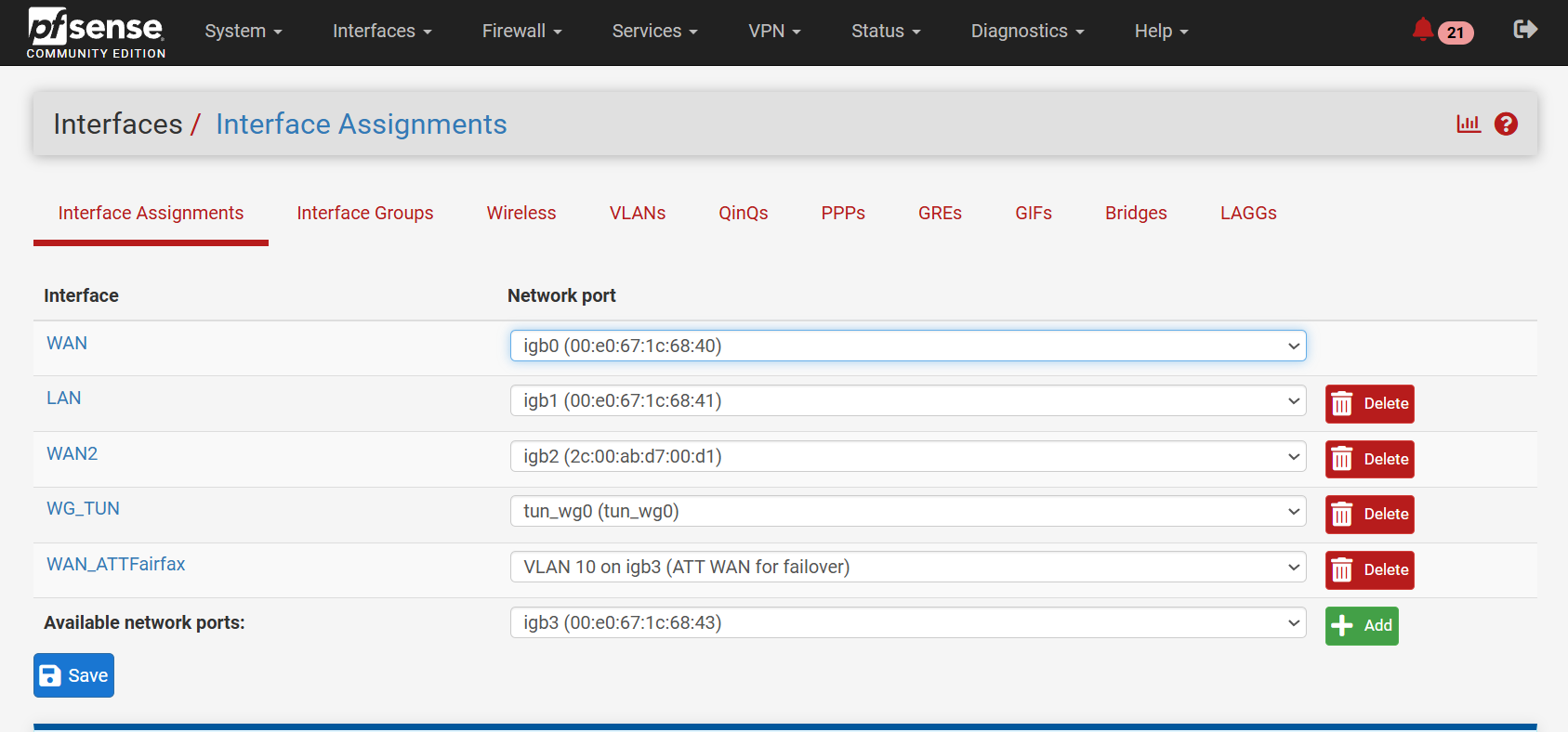
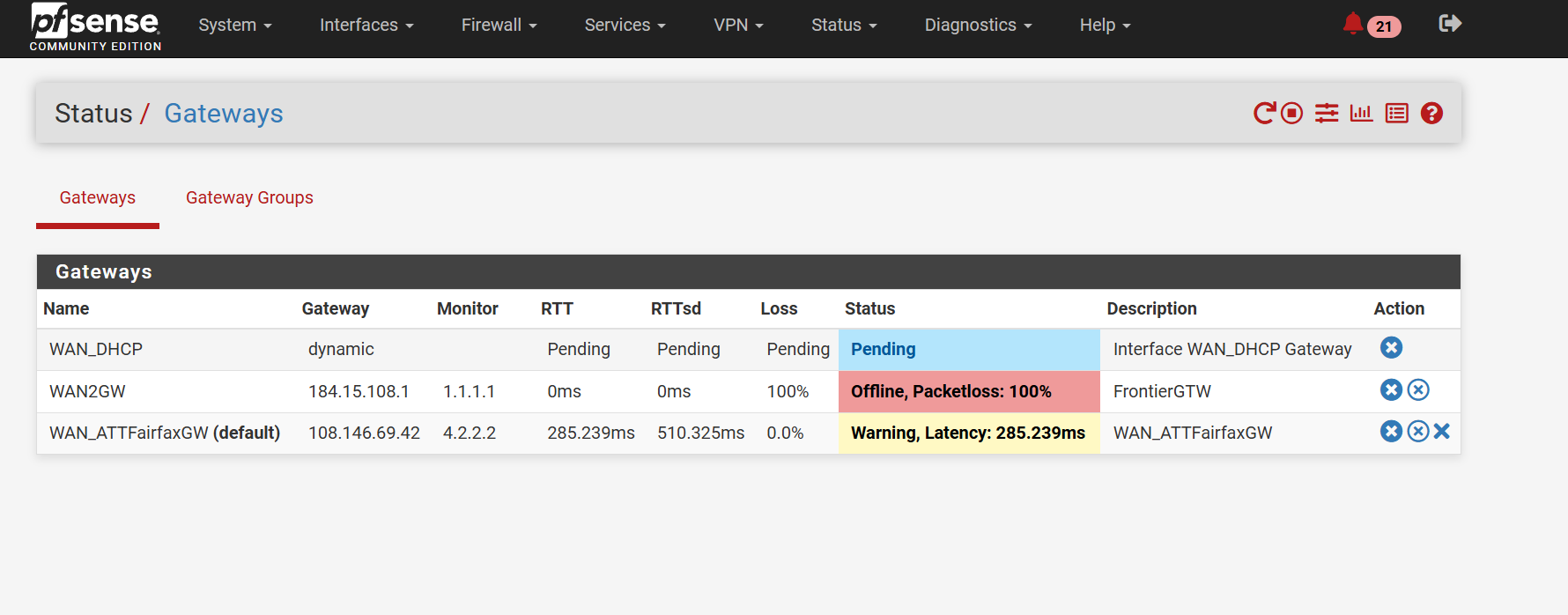
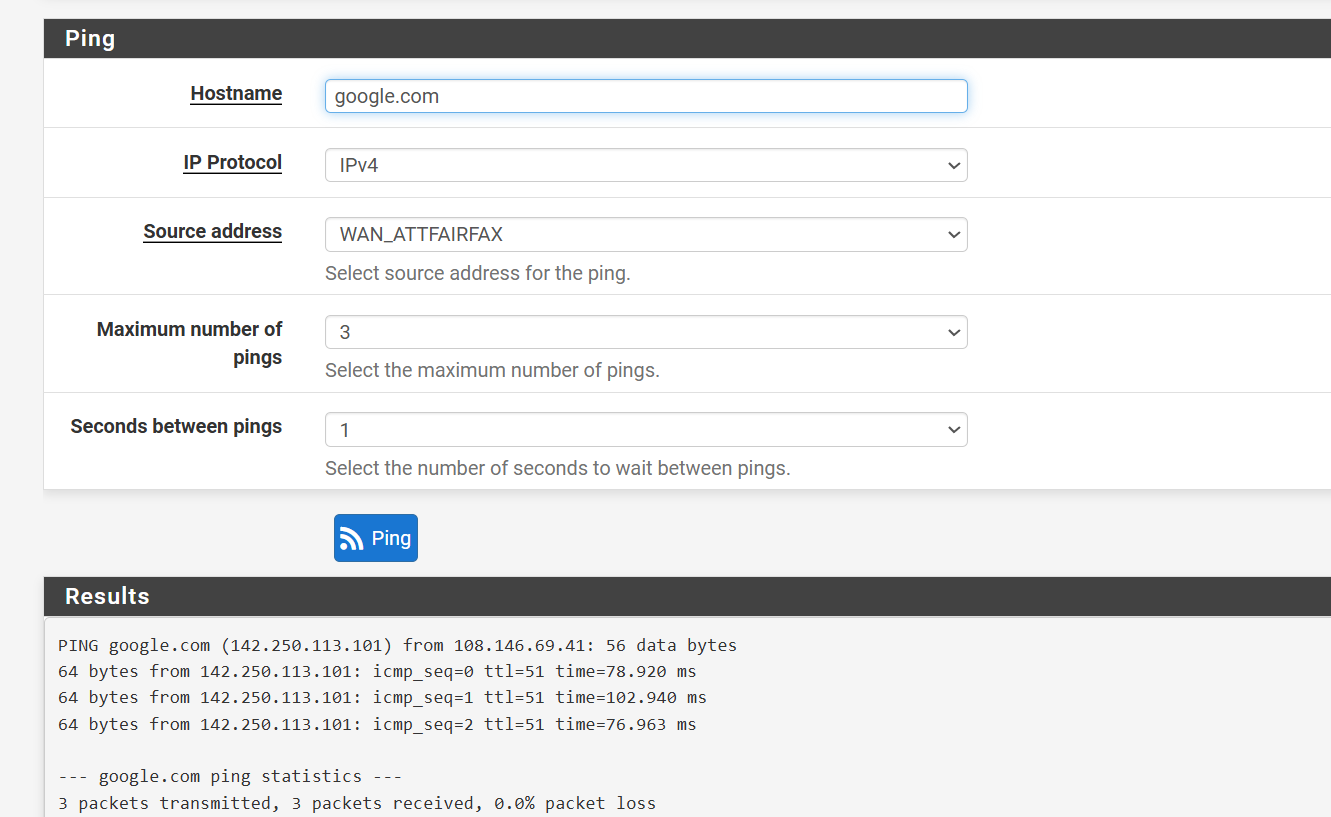
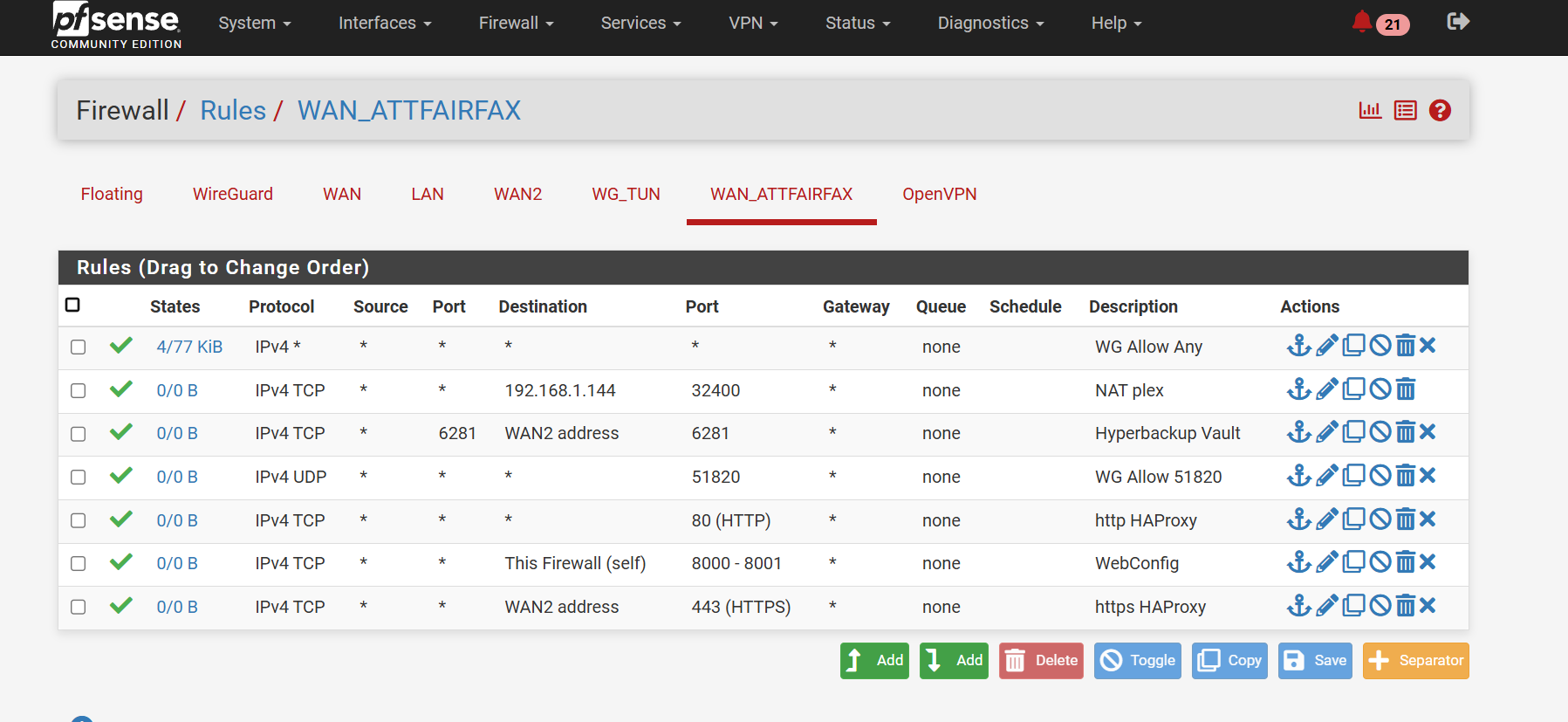
-
@ahole4sure I think you could perhaps make things a bit simpler than what you are looking at now.
I am using an LTE router as my failover WAN, and I have quite a few VLANs for Cameras, Guestwifi, VoIP and so on. However, I only have 3 ports on my pfsense, but even if I had more, I doubt I'd use more...
The way I have it set up is with two separate ports only used for the respective WAN connections, and then one single LAN port, carrying all VLANs. So what I would propose, is something like this adjusted picture, which I also suspect will help you getting your ATT connection a bit simpler to set up, is this:
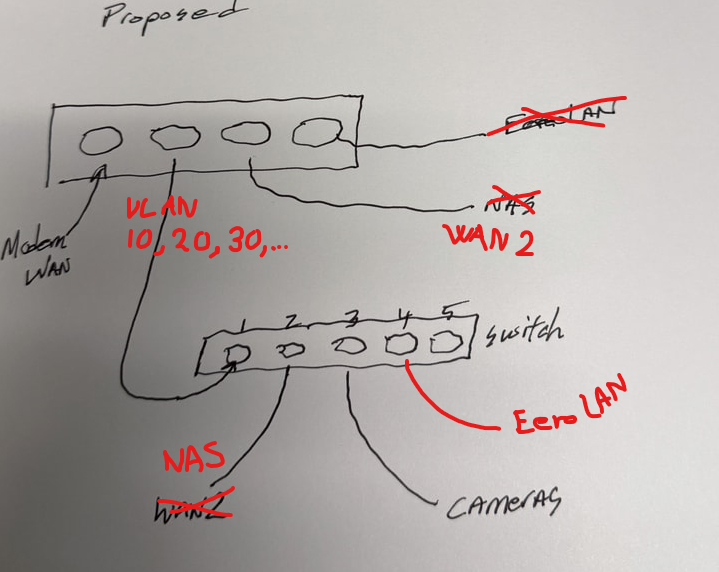
In your switch you set port 1 as TRUNK, with all VLAN ID's as TAGGED. Then you simply set each port on the switch to the VLAN you need, Port 2 could be 20 UNTAGGED, Port 3 is 10 UNTAGGED and Port 4 is perhaps default 1 (your main LAN?).
If you have more switches involved in your network you need to connect them together. And if you need VLAN's to carry over to the next swtich, that is done via TRUNK ports. Meaning that all VLAN ID's that you want to be passed along have to be TAGGED on those ports, in both switches. Since port 3 is UNTAGGED, you can connect a dumb switch to it and attach any number of cameras, and they will all be part of the Camera VLAN (without knowing it themselves...).
Since the ATT Modem is a 5G modem, you may want to place it somewhere with a really good connection, provided you have cabling for it in your home. If you don't have a cable that is unused, meaning it's already used for something else like an AP or so, you can use VLAN to "tunnel" the ATT WAN connection to the pfsense port.
If you put a VLAN capable switch also at the location where the ATT modem sits, you can create a switch only VLAN ID (say 100) and set the ATT connected port to 100 UNTAGGED. Include ID 100 in the TRUNK that connects the switches, and then set the port connecting into pfsense to 100 UNTAGGED.You don't have to do anything with VLANs on the second WAN port... VLAN ID 100 is only known and used by the switches, and becomes a switch within the switches only for "tunneling" the that extra WAN connection.
This is what I do in order to have my LTE modem on the top floor and the switch connecting the floors is not the one directly connected to pfsense.
-
If pfSense pulls a lease via DHCP when connected directly to the modem it should also do so when connected via the switch.
Since you have set ports 3, 4 and 5 to be access ports of VLAN20 the PVID needs to be 20 on all three of them.
-
Thank you both for chiming in so quickly!! Really helpful thoughts because I have a full switch up in the ceiling area for the cameras and re-designing my network with another or new VLAN capable switch up in the ceiling for the modem might be the way to go - thanks @Gblenn for the thoughts.
My real issue now is that I don't understand why my ATT modem set to passthough mode is not sending the IP address through the VLAN to the pfsense with the interface set to DHCP mode ?? (like I thought I remembered it doing for the first ATT modem I setup a couple weeks ago)
Does a modem device set to pass through "normally" send the info through to the router it's connected to?? I seem to remember that with my cable/fiber modem I had the manually set the IP address for the interface. But I swear that I remember the first ATT modem pushing through the IP.
And apologies for the weirdness of my situation partly induced by my second location being 5 hr drive away - would require drive, hotel stay, etc if I can't get this troubleshooting done remotely and by testing
-
Yes I would expect it to allow pfSense to pull a lease from AT&T directly. But I think you need to confirm that with a direct connection.
If you got any part of the VLAN or switch setup wrong it would just fail entirely. Since you are seeing ping responses to it (with high latency) it is passing traffic so the switch/vlan config is almost certainly correct.
-
@ahole4sure I think you are right in your assumption that the modem should pass through the IP from the ISP if it's in bridge mode. It may however also make use of VLAN for the management interface? Check the manual?
In this picture I see that you have not assigned the parent interface igb3, only VLAN 10?
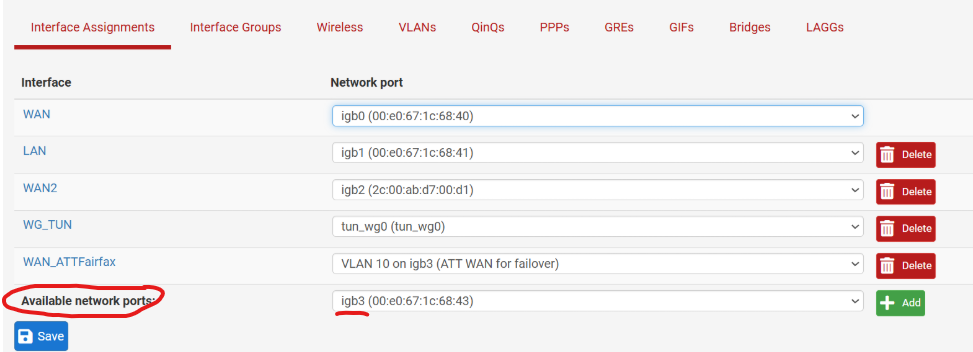
And this should work, and it should receive an IP from ATT and pass traffic.. But I would have removed that assignment and use the parent interface igb3 as is instead. Simply setting it up like you did with igb0.
One thing that may mess things up is that you also have VLAN 1 on ports 1 and 2. So you could end up having some other device on the switch picking up the IP from ATT?? If you clean it up and remove any other VLAN membership than VLAN 10 on port 1 and 2.Or, perhaps the intent is to actually use the secondary WAN port also for LAN traffic? Although you have more than enough ports so I can't see that it's necessary...
Perhaps a better understanding of your desired setup would be good?
WAN1 - Fiber connection (igb0)
WAN2 - 5G connection set up as failover (igb2 to be used once you are through testing?)
LAN - this is default VLAN tag 1 on all switches. Is this what you called EeroLAN in the drawing?VLAN 10 to be used only to pass along the 5G modem connection.
VLAN 20 is for Cameras
VLAN NN for NAS?? -
@Gblenn The pics above , I believe , explain what is needed. Bottom line I have had a network setup for 2 years running flawlessly. The problem was that we decided we needed failover internet after a recent outage (and resultant business loss). The issue was that all 4 ports on the pfsense device were full
So we decided to at the switch and utilize VLANs to turn one port on the pfsense into 2 ports ...
1 - for the addnl WAN
and the 2nd) - for the orginal Camera LAN that was already connected to the port on the pfsense originallySince that port will be utilized as a trunk for both the new WAN and the existing Camera LAN I am not clear on how I should "assign" the parent interface ??? Maybe @stephenw10 could offer insight on this as well. I understand that the parent interface can remain assigned - but how do you assign a parent interface??
-
You don't need to assign the parent interface if you are using two VLANs for the two subnets.
You would only assign the parent if you want the trunk link to carry untagged traffic and my preference is to avoid that if possible. And it's certainly possible here.
-
@ahole4sure said in ATT Internet AIr:
Since that port will be utilized as a trunk for both the new WAN and the existing Camera LAN I am not clear on how I should "assign" the parent interface ??? Maybe @stephenw10 could offer insight on this as well. I understand that the parent interface can remain assigned - but how do you assign a parent interface??
Like @stephenw10 is saying, you don't have to. It was just my idea of putting all VLAN's on one interface, which included your default LAN. But that would also mean having untagged traffic on that trunk, which isnt' really best practice I suppose...
If you want to use that port for both Camera and ATT WAN, I guess you are missing VLAN 20 on the pfsense side. So that needs to be added like you did with VLAN 10.
-
@stephenw10
Again thank you for your help!
This is probably a continued VLAN question but I think there is some pfsense general stuff going on.I finally got the 2 Failover modems to connect to the pfsense as intended - BUT it took hours of experimentation.
Main question(or topic) is that I just couldn't get DHCP to work for creating (and maintaining) the interface and esp the gateway -- it seemed to have to do with assigning the parent interface (or not) and possibly some weird MAC addresses showing up (maybe it was the MAC address of the switch port (not really sure) ...
the only way I seemed to have a stable configuration was to set the VLAN interface to static , create a "static" gateway, and then HAD to delete the gateway that was auto created by the DHCP initially
Note: the DHCP config of the VLAN interface worked initially but then the created gateway started showing weird addresses (not even on my network) like 192.168.224.1 (see FIRST PIC ) ( the subsequent remaining pics are the working setup that ended up after static config)Any ideas why the DHCP setup / config is failing? Is it MAC address issues? When a DHCP server doles out an address to VLAN what MAC address does it see? Does it see the parent interface MAC address? And what if the parent MAC address is configured and then used as a VLAN trunk - is the same MAC address used for the parent and the VLAN interface??
I can use the static as long as ATT is willing to keep providing static addrress for my modem. So that's not the end of the world but it would be nice to understand the process for the future ..... I even have a third location with much different network for later
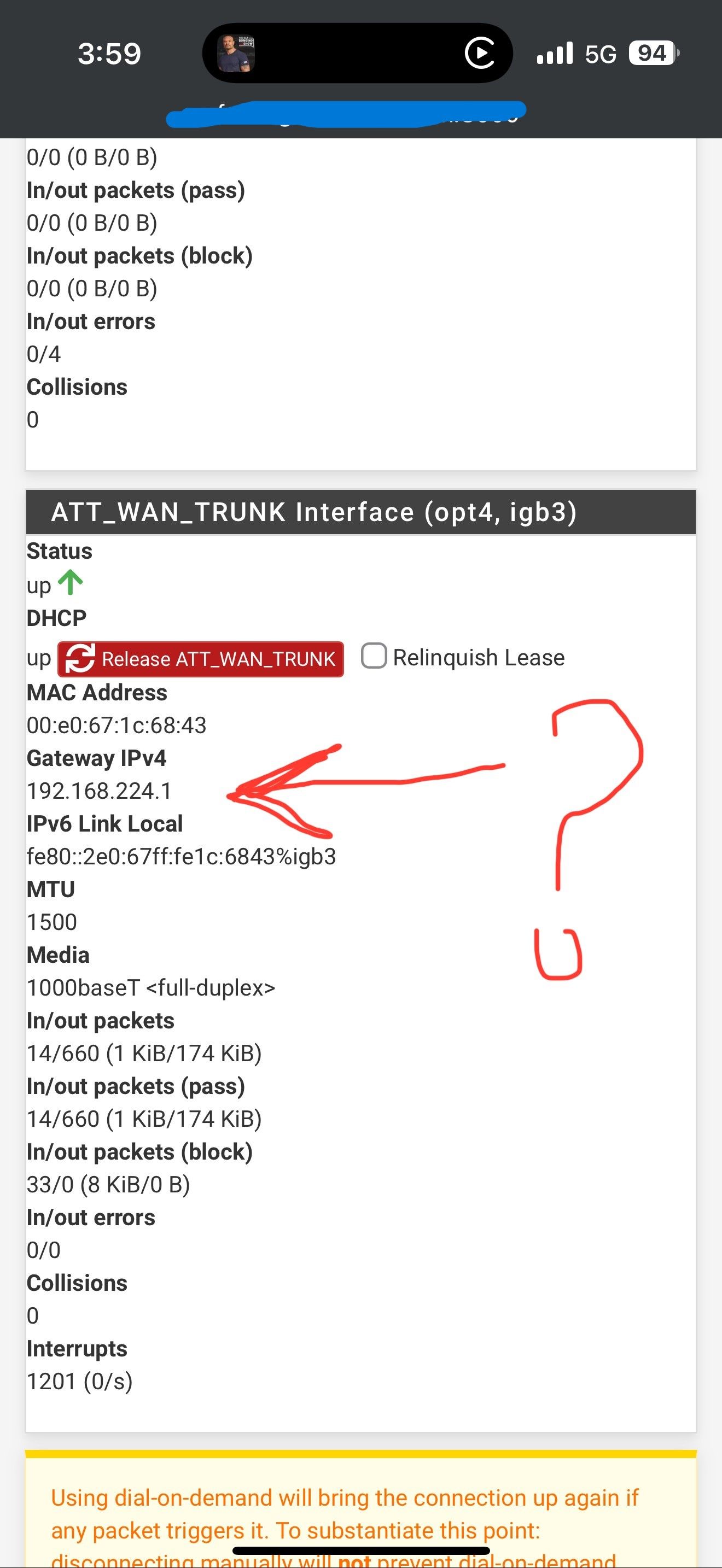
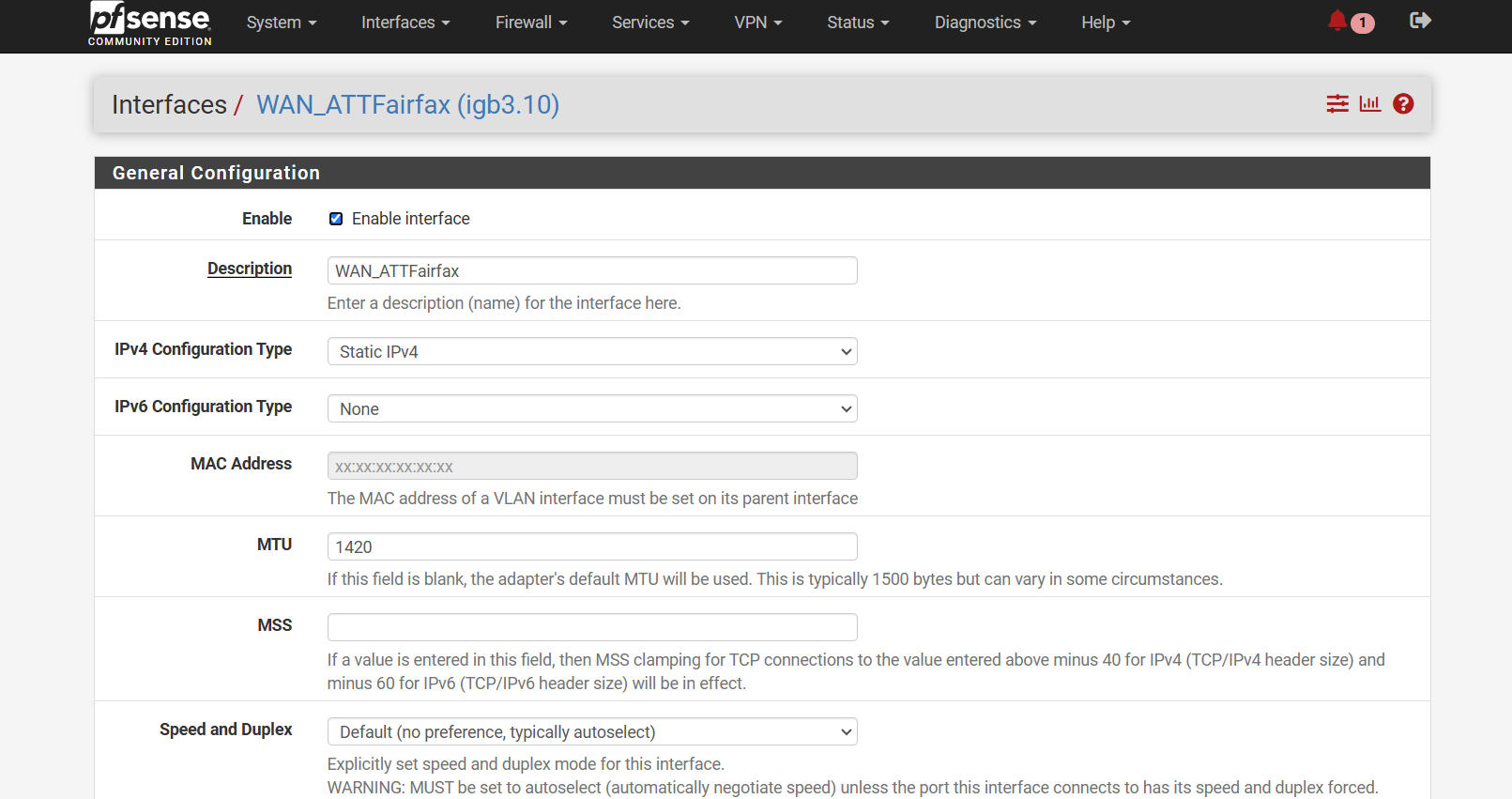
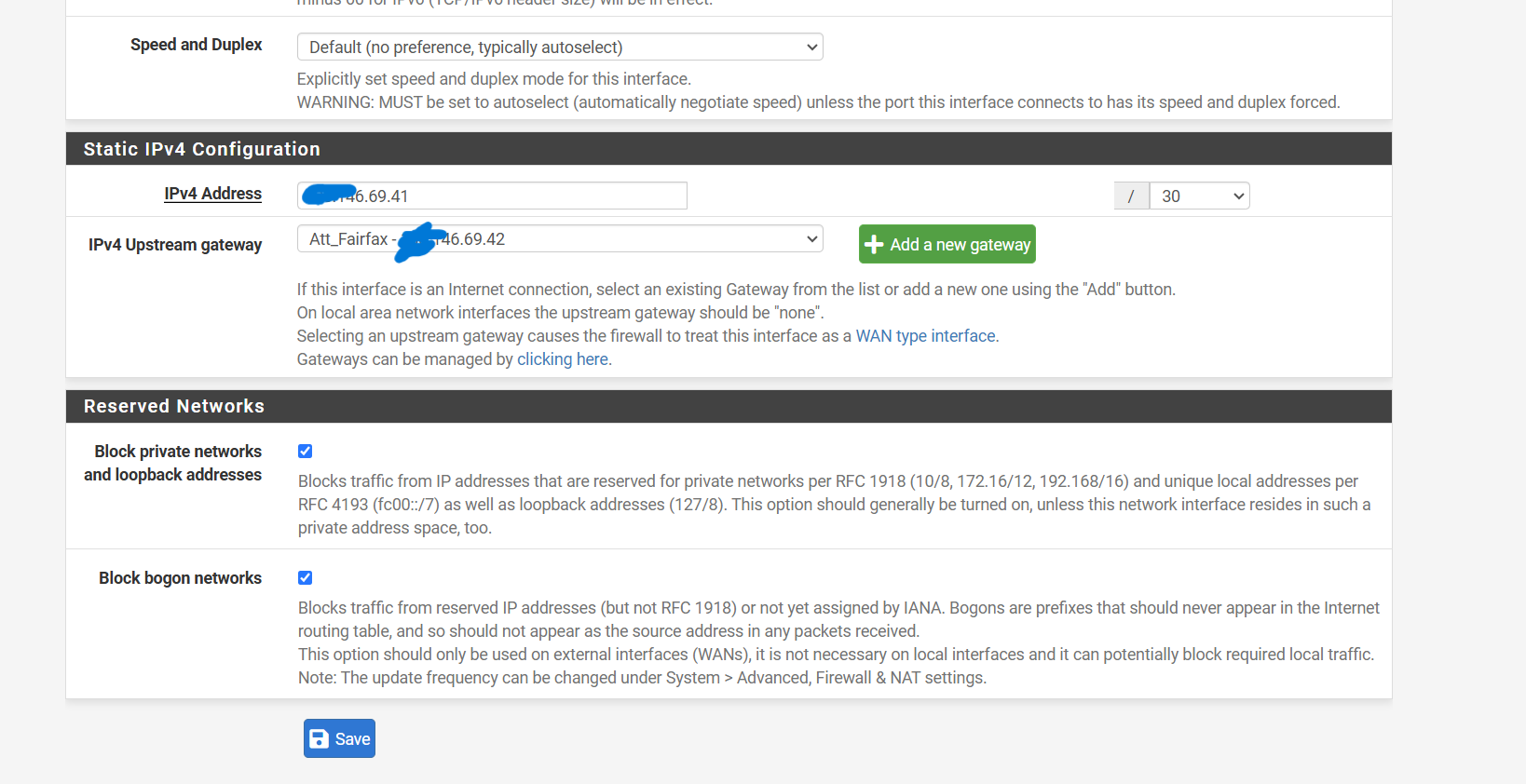
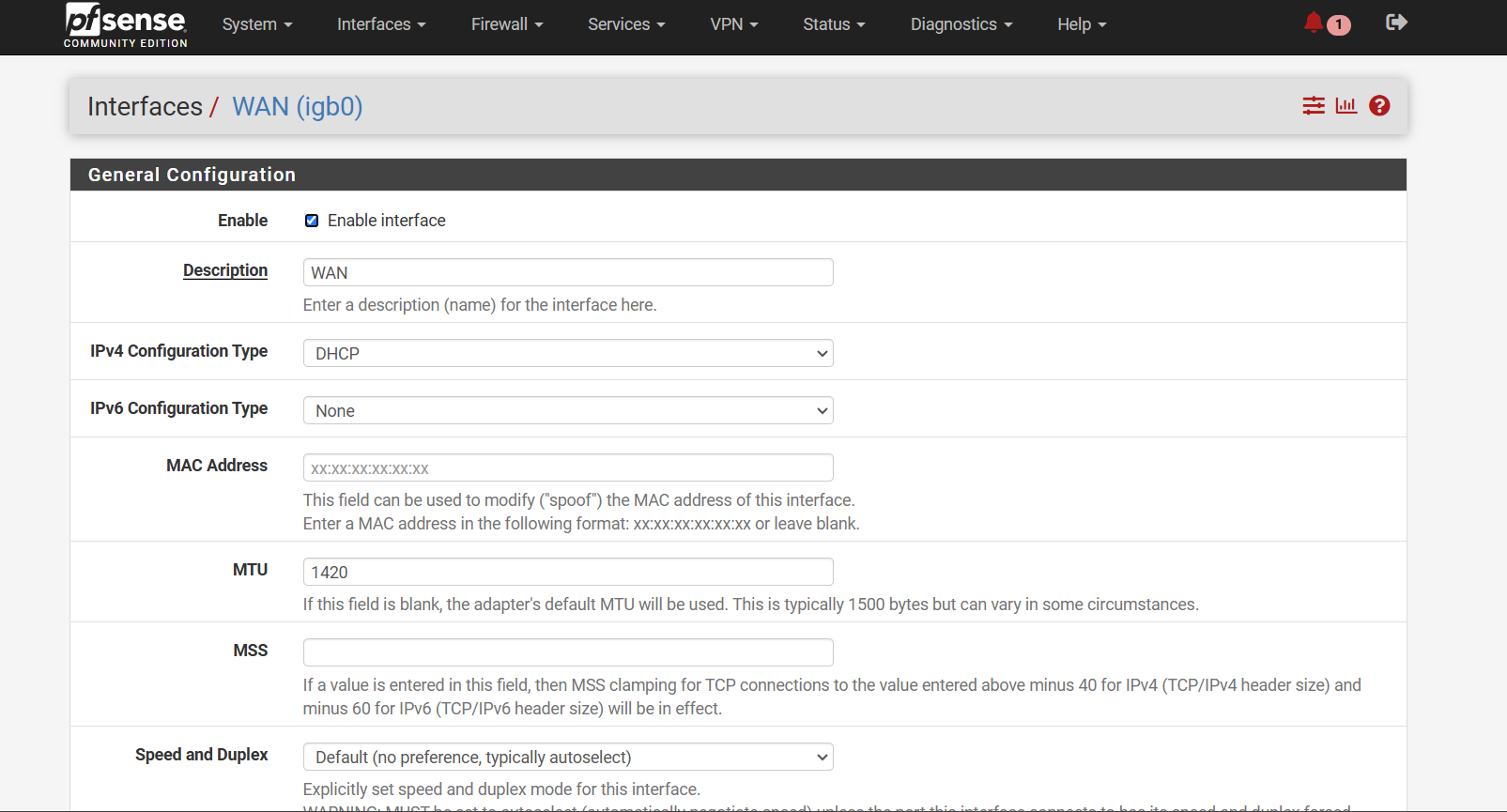
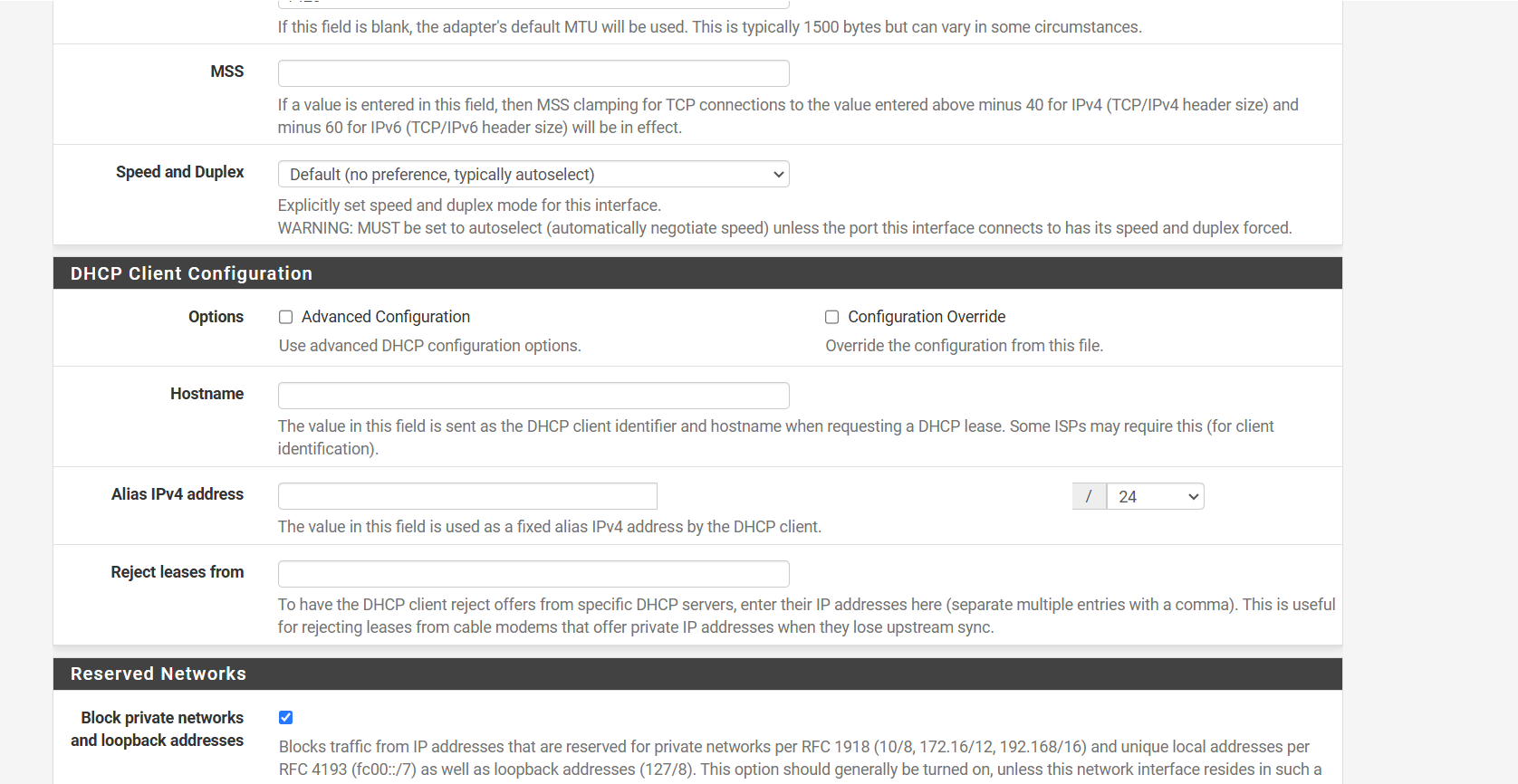
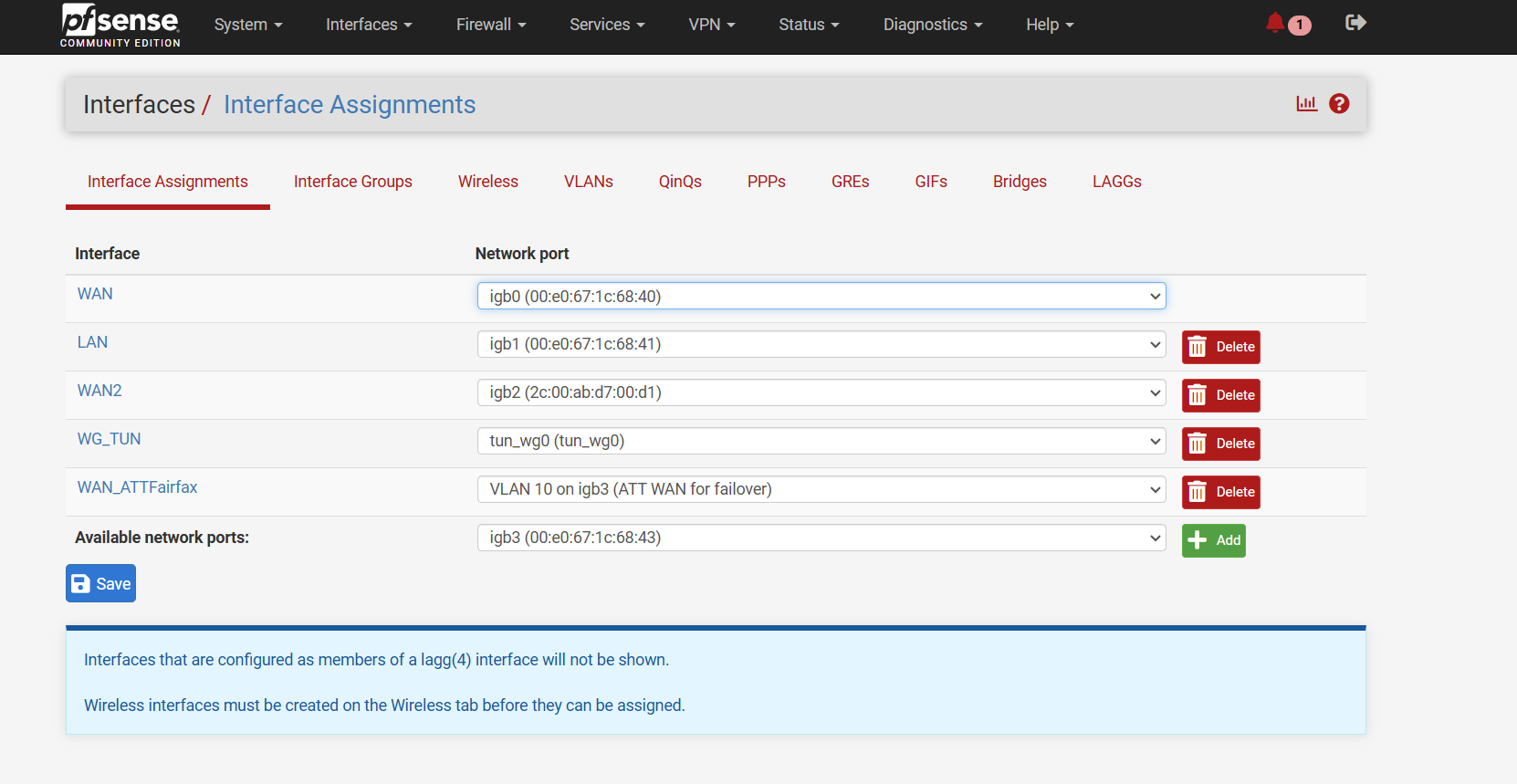
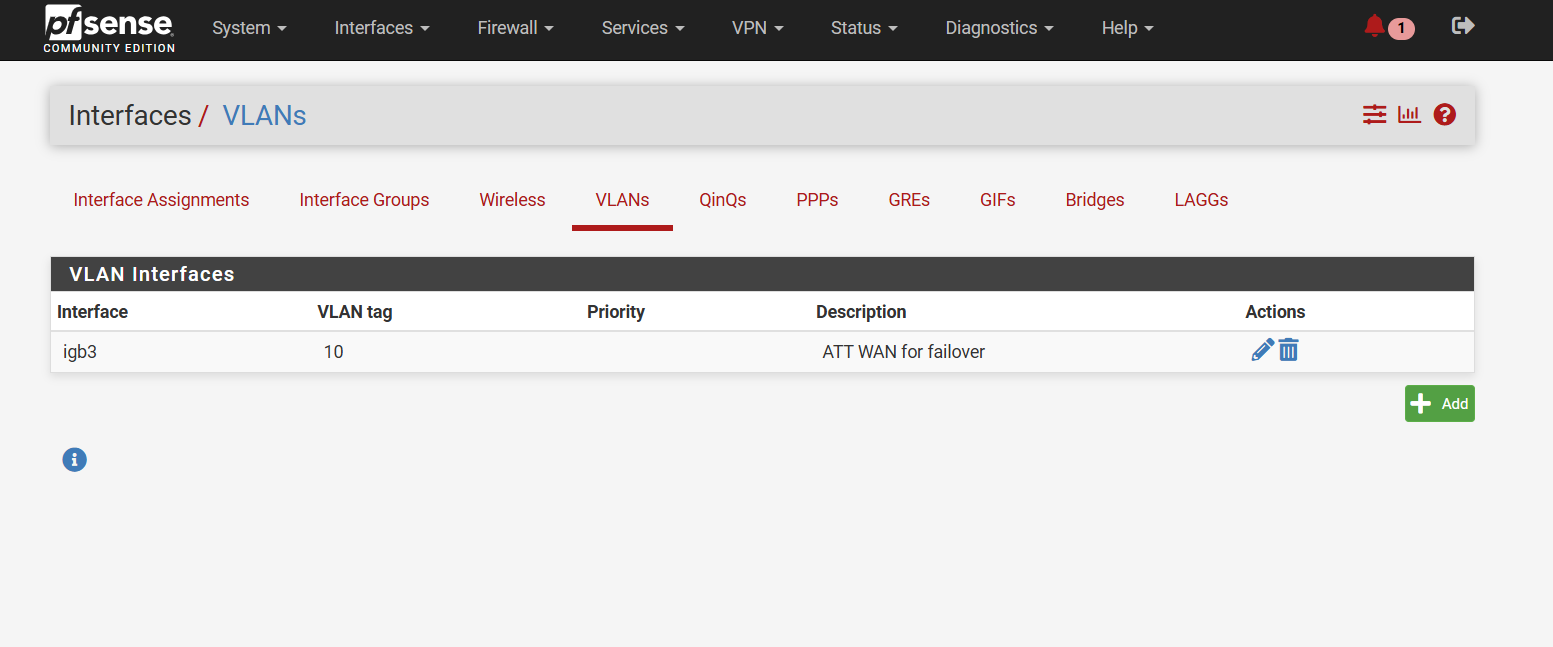
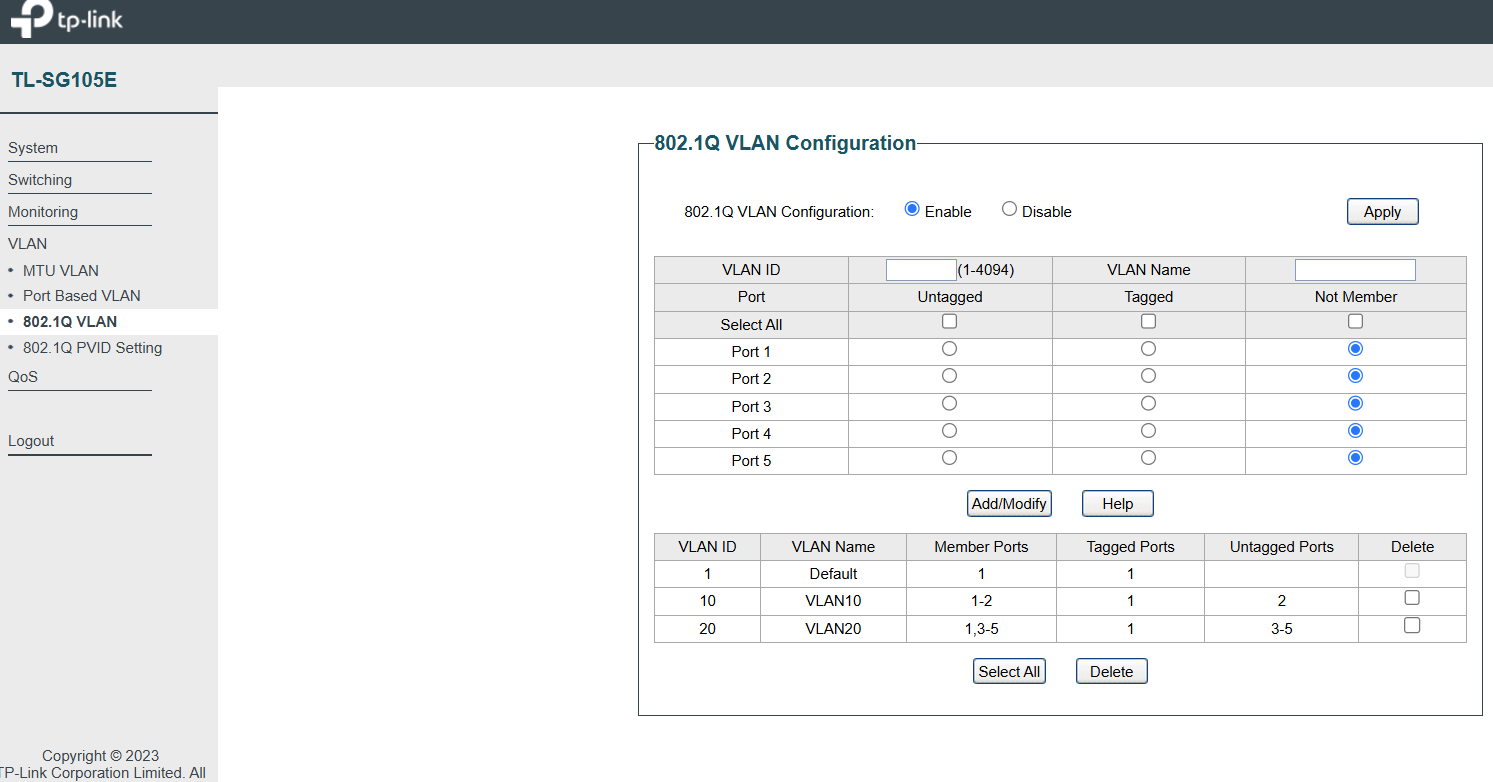
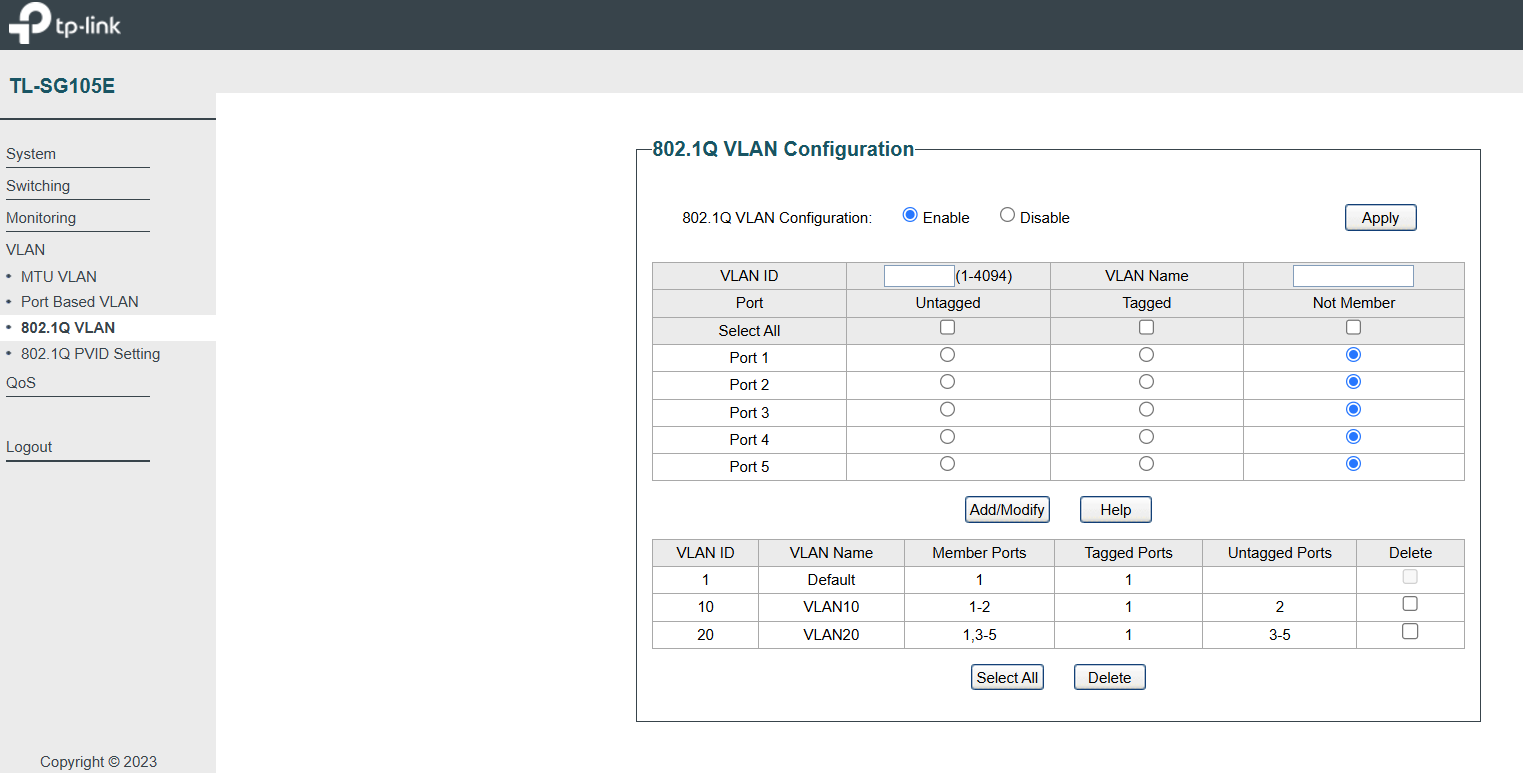
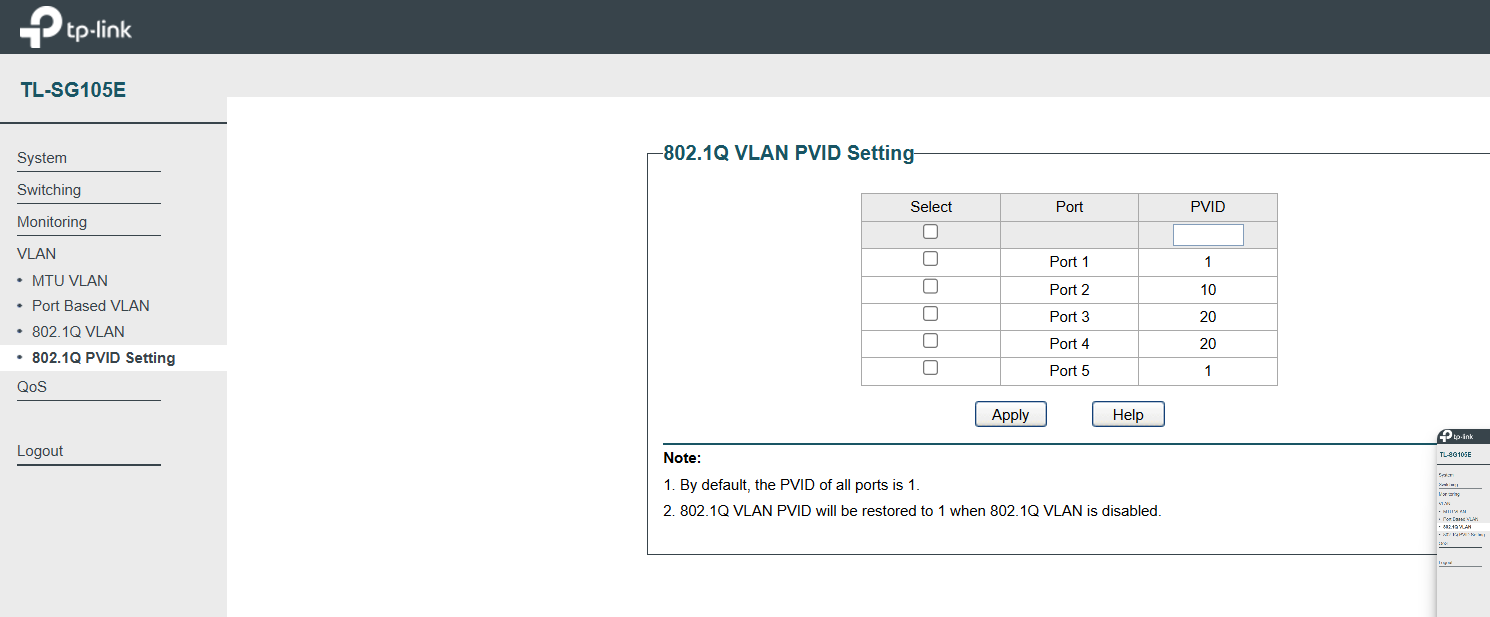
-
@stephenw10
here are the rest of screenshots
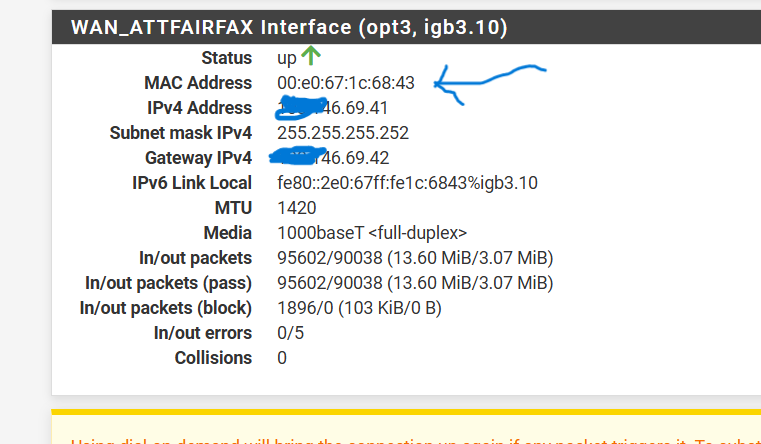
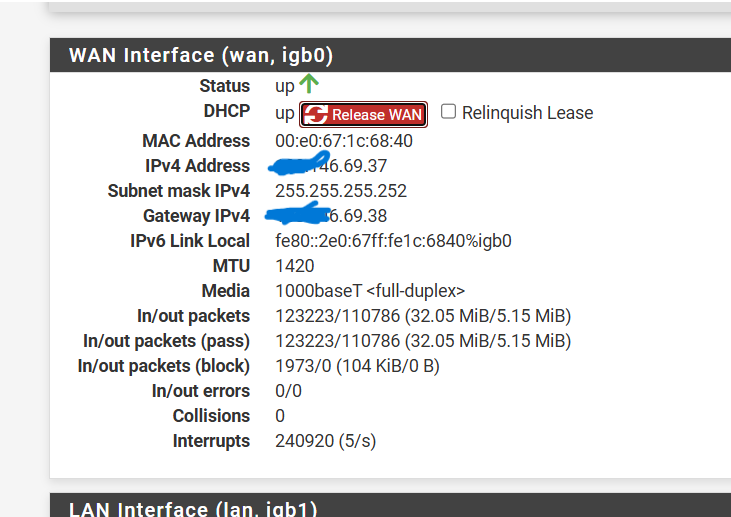
-
@stephenw10
Here are the rest